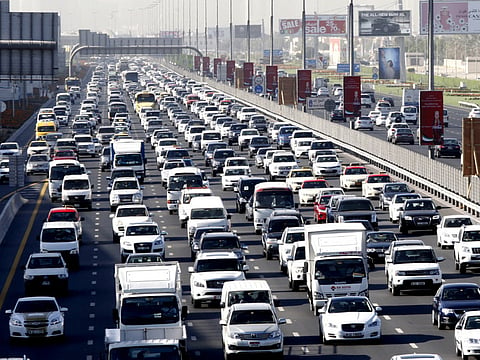Odd-Even: Will it cut congestion in Dubai?
Odd-even number plate policy on given days was considered, says RTA

DUBAI Sao Paulo implemented it in 1997, Beijing did it more than a decade later during the Summer Olympics in 2008 and Parisians saw a second coming as recently as this year. Some of the world’s most severely congested cities have taken to ‘road space rationing’ for good measure, most by limiting access to cars to almost half the population on a given day based on vehicle number plates. Is Dubai – where vehicle density at 540 per 1,000 people according to latest reports is not only the region’s highest but more than some of the busiest urban centres of the world – ready to take a cue?
Major restrictions
Ask the Roads and Transport Authority (RTA) and the proposition of an ‘even-odd’ number plate rationing appears quite relevant to Dubai. “The RTA has identified and considered within its studies a number of travel demand management measures and transportation policies including even-odd plate numbers in terms of allowing vehicles with odd plate numbers in certain days of the week and certain areas of the city and even numbers during the remaining days of the week,” Nasser Abu Shehab, RTA’s Executive Director of Strategic Transport Planning, told XPRESS this week. “In general certain ideas can work better in certain parts of the world. In Dubai in particular and the UAE in general, the government plans to delight people and hence there is a clear intention not to pose major restrictions on people’s choices,” he added.
However, Paul Velasco, the communications manager at the Dubai Autodrome, says the idea of controlling traffic by number plate rationing in the UAE will be difficult as the public transport system is not developed enough to cater for outlying areas yet. “Although it has developed impressively in a very short time, it tends to be linear and services a very narrow population band. What about Springs? What about Ranches? And all the areas not yet adequately serviced by public transport,” asks Velasco who suggests the solution may lie in looking at the major cause of traffic disruptions, namely accidents and bad driving instead. “Drivers blatantly breaking the law eg. speeding, driving on hard shoulder, parking and stopping illegally – causing congestion – should be dealt with harshly and may even banned from driving for certain periods,” he adds.
Dutchman Marco Blankenburgh who is the International Director of KnowledgeWorkx, a Dubai-based company that specializes in helping people ‘thrive in globalized world’, echoes similar sentiments. “Back home in the Netherlands where I come from, it worked wonders where we even have car free days and that’s because there’s a great network of public transport. Sometimes in harsher climates especially during summer here, using the public transport may not be seen feasible for many,” said Blankenburg who was also of the opinion that more should be done however to ‘make cars less affordable.’
Odd ones out
During 2008 Summer Olympics, Beijing implemented a temporary ‘road space rationing’ based on plate numbers for two months before a modified version of the restriction was made permanent in Beijing in October 2008 that now bans 20% of the vehicles on a given weekday.
São Paulo has ‘no-drive days’ based on license numbers, implemented since 1997 while several other South and Central American cities like Santiago, Bogota, Quito, La Paz and Mexico City have various other forms of road space rationing in place.
The 2012 Summer Olympics was publicized as the “First Car-free Olympics” due to ‘auto exclusion zones’ around venues.
Sign up for the Daily Briefing
Get the latest news and updates straight to your inbox


